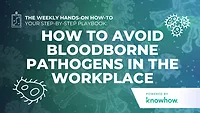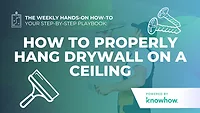Weekly Hands-on How-To powered by KnowHow
How To Avoid Falls on a Jobsite
.webp?t=1737149336)
All images provided by KnowHow.
Falls are one of the leading causes of injuries and fatalities on construction sites, yet they’re also some of the most preventable. Whether working at towering heights or navigating day-to-day risks like ladders and scaffolds, fall protection requires a proactive approach to safety. From understanding OSHA regulations to recognizing potential hazards, every step you take can make a life-saving difference.
In this how-to, powered by KnowHow, we’ll break down the essentials of fall prevention and protection. You’ll learn how to identify hazards, implement safety measures, and build a culture of awareness and compliance. With the right knowledge and tools, you can ensure a safer work environment for everyone on the job site.
So, let’s jump… wait, no. Let’s carefully descend into this one!
Step 1: Understand the Relevant OSHA Standards
Fall protection begins with a thorough understanding of the OSHA standards that apply to your work. These regulations are in place to minimize risks and ensure safety. Familiarize yourself with these key standards:
- OSHA Standard 1926.501(b)(1): Each employee on a walking/working surface with an unprotected side or edge 6 feet (1.8m) or more above a lower level must be protected by guardrail systems, safety net systems, or personal fall arrest systems.
- OSHA Standard 1926.451(g)(1): Each employee on a scaffold more than 10 feet (3.1m) above a lower level must have fall protection in place, such as guardrails.
- OSHA Standard 1926.1053(b)(13): The top or top step of a stepladder must not be used as a step.
Understanding and applying these standards is essential for ensuring a safe work environment and compliance with regulations.
Step 2: Recognize Possible Fall Hazards and How to Prevent Them
Awareness is your first line of defense against falls. Fall hazards can arise at any height above 6 feet, but even ground-level hazards must be addressed. Always assess your work area for unprotected sides and edges, and consider guardrails or other barriers to minimize risk.
Proactively prevent hazards by:
- Installing barricades, temporary barriers, or warning lines to alert workers to potential dangers.
- Using clearly marked signs—danger, warning, and caution signs—to communicate hazards.
- Ensuring proper fall protection, such as guardrails or personal fall arrest systems, when working at height or on scaffolding more than 10 feet above a lower level.
Fall prevention isn't just about awareness; it’s about actively creating a safer workspace.

Step 3: Recognize Where Fall Hazards Can Be Found
Fall hazards aren’t limited to towering heights—they’re present in many day-to-day construction activities. Recognizing these high-risk areas is critical:
- Ladders, especially when improperly used or placed.
- Openings, such as excavations, pier holes, or unprotected floor holes.
- Makeshift platforms, buckets, or scaffold-like surfaces that lack stability.
- Attics or overhead crawlspaces where footing may be uneven or unstable.
- Road construction sites on bridges or overpasses.
- Rooftops near skylights or edges without guardrails.
- Scaffolding, scissor lifts, or boom lifts requiring proper fall protection.
By identifying these areas upfront, you can implement safety measures before accidents happen.
Step 4: Follow These General Safety Principles
Adopting basic safety principles can drastically reduce the likelihood of falls. Start with a walk-around inspection of the job site to pinpoint and address potential hazards. Supervisors and workers should collaborate to identify risky areas and plan for necessary precautions.
Remember these essential practices:
- Avoid working near unprotected skylights, sides, or edges without adequate fall protection.
- Ensure all workers using aerial lifts or man lifts receive training and wear required fall protection gear.
- Always face ladders when climbing and avoid using the top step as a platform.
- Require fall protection for any task performed at a height of 6 feet or more above a lower level.
Consistently reinforcing these principles builds a culture of safety on-site.

Step 5: Spot the Potential Fall Hazards in Photos
Recognizing fall hazards visually is an excellent training tool for identifying risks in real-life scenarios. Study photos or examples of job sites to practice spotting hazards like unguarded edges, unstable platforms, or missing guardrails. This exercise sharpens awareness and enhances hazard recognition skills among workers and supervisors alike.
Step 6: Watch OSHA’s Fall Protection Video
OSHA’s fall protection video offers valuable insights into safety regulations and best practices for preventing falls. Use this resource as a training tool for your team to stay informed about the latest standards and techniques for fall prevention in construction.
Confidently Prevent Falls with KnowHow
Fall hazards are a constant presence on job sites, but with the right preparation and tools, they’re entirely preventable. By following OSHA standards, addressing risks proactively, and fostering a culture of safety, you can protect your team and ensure a secure workplace.
KnowHow makes it easier to follow those rules and stay compliant. With instant access to guidance, real-time training tools, and features that keep your team informed and confident, KnowHow simplifies safety every step of the way. Ready to empower your crew?
Book a demo today and see how KnowHow transforms workplace safety into a seamless part of your process.
Looking for a reprint of this article?
From high-res PDFs to custom plaques, order your copy today!








